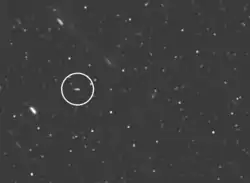Tarqeq
Tarqeq, also known as Saturn LII (provisional designation S/2007 S 1) is a natural satellite of Saturn. Its discovery was announced by Scott S. Sheppard, David C. Jewitt, Jan Kleyna, and Brian G. Marsden on 13 April 2007 from observations taken between 5 January 2006 and 22 March 2007.[1][2] It is named after Tarqeq, the Inuit moon god,[5] and is a member of the Inuit group of irregular satellites. It is about seven kilometres in diameter.[6] The Cassini spacecraft observed Tarqeq over 1.5 days on 15–16 January 2014.
 Tarqeq imaged by the Cassini spacecraft in June 2016 | |
| Discovery[1][2] | |
|---|---|
| Discovered by | Scott S. Sheppard David C. Jewitt Jan Kleyna Brian G. Marsden |
| Discovery date | 13 April 2007 |
| Designations | |
Designation | Saturn LII |
| Pronunciation | /ˈtɑːrkɛk/ |
Named after | Tarqiup Inua |
| S/2007 S 1 | |
| Adjectives | Tarqiupian, Tarqeqian[3] |
| Orbital characteristics[1] | |
| Epoch 2007 Apr. 10.0 | |
| 17.9106 Gm | |
| Eccentricity | 0.1081 |
| 894.86 d | |
| Inclination | 49.90° |
| Satellite of | Saturn |
| Group | Inuit group |
| Physical characteristics | |
Mean diameter | 6+50% −30% km[4] |
| 76.13±0.01 h[4] | |
The Tarqiup (Tarqeqian)[3] orbit lies at an inclination of 49.90° (to the ecliptic; 49.77° to Saturn's equator), with an eccentricity of 0.1081[1] and a semi-major axis of 17.9106 Gm. Tarqeq orbits in a prograde direction with a period of 894.86 days.
References
- MPEC 2007-G38: S/2007 S 1 13 April 2007 (discovery, prediscovery and ephemeris)
- IAUC 8836: S/2007 S 1, S/2007 S 2, and S/2007 S 3 11 May 2007 (discovery)
- The genitive form of Tarqeq is Tarqiup (as in Tarqiup Inua 'Master of the Moon'). Thus the adjectival form could be absolutive Tarqeqian or genitive Tarqiupian, parallel to nominative Venusian and genitive Venerian for Venus. See Inuktitut morphology
- Denk, T.; Mottola, S. (2019). Cassini Observations of Saturn's Irregular Moons (PDF). 50th Lunar and Planetary Science Conference. Lunar and Planetary Institute.
- IAUC 8873: Satellites of Saturn 20 September 2007 (naming)
- Saturn's Known Satellites Archived 2008-01-19 at the Wayback Machine
.jpg.webp)